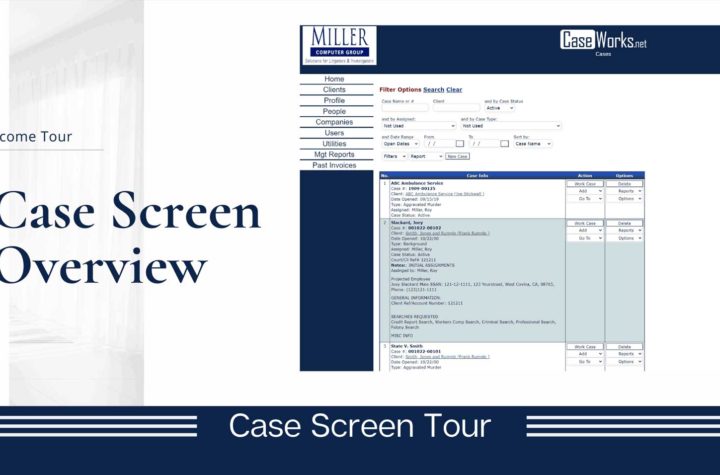Wow Your Clients

It’s often one of the last things you think about on a case. It’s usually one of the things you do. But devoting some extra time and energy to this critical part of any investigative project – in essence, adding the “Wow” factor – can pay enormous dividends in getting future assignments and building your business. We’re talking about your written report to your client. “Reports?!” you may be screaming. “I hate writing reports! I love the challenge, the excitement of the actual investigative work. I mean, I keep my reports very accurate, but I don’t like spending a lot of time on them.” Yeah, it shows.
The difference between providing a report that covers the bare necessities and a report that truly impresses your clients with its completeness, its presentation, and its ease of use is what can truly set you apart from all other investigators. The distinction of producing a high quality product – be it automobiles, whiskey, vacation resorts, or even, yes, investigative reports – is powerful, especially in the realm of marketing.
So what makes a report “high quality?” Two main factors: consistency and thoroughness.
Consistency is simple. It means that all of your reports are of a very high caliber. One is not great and the others average; they’re all great. Time and time and time again. You are so consistent that your client knows, in fact he expects, that the next report you submit will be as efficient, as accessible, and as useful as all the others your agency provides. You have set the bar high yourself. And while your systems and experience in issuing impressive reports enables you to easily get over that bar, your competition falls short.
As for thoroughness, many things make a report thorough and complete. First, never assume anything. You may never know who is ultimately going to read your report, and what they may or may not know about certain affairs that are critical to the report. Maybe everyone going to see Star Wars II has actually seen Star Wars I, so you don’t have to spend too much time introducing all the lovable but wacky characters. But never make that assumption in your report. Spell everything out, because your report must stand on its own.
Completeness in your report also demands that you identify activities that perhaps were not productive. Maybe in the course of your investigation you did a neighborhood canvas, going door to door in the immediate area to ask specific questions. It’s possible that this canvassing did not produce any useful information. However, your report should still note that you went through that process, and that it had no impact. That way your client won’t think, “Gee I wonder if the neighbors knew anything?” You have shown your client that you anticipated his needs and that result is reflected in your report.
An especially powerful component of a complete report, and something that most investigative reports do not include, is an executive summary. This is a one-page (never more than one page) synopsis of your investigation. (In fact, if your executive summary is more than one page long, you are doing a disservice to your client.) This summary presents key findings, supported by detail, and enables your client to decide for himself what else he wants to review in the report.
The executive summary goes right to the heart of the topic under investigation. It is not subjective, nor is it interpretive. For example, your summary should not state that so-and-so lied. Instead, you simply point out the inconsistencies, identify the facts, and indicate where additional information can be located in the report. It’s just the facts, Jack.
Producing an effective executive summary is really an art. However, once you master this art form, your work will truly impress your clients, and it can result in significant repeat business for you. Providing a carefully prepared, factual executive summary will surprise your clients when they receive it, because virtually no one else does it. In fact, they will probably be so surprised that they will pass it around to others, which is how it becomes a powerful marketing tool. It leaves a telltale sign of who you are, and the standards you set for your business and yourself.
Other Components of a Quality Report
Here are some other elements you can incorporate into your reports to enhance the quality and elevate your clients’ impression of you. Adding a table of contents is a simple yet effective way to guide your client to the key facts you have presented in the executive summary. Make it easy for people to use your report, and they will want to use more of them in the future. Just putting the whole report on heavy bond paper also makes it more impressive. For heavens sake, go spend $10 on an first class cover. This shows your client that you recognize what they already know: this is an important project, and you have given it the importance it deserves, start to finish.
Furthermore, in presenting the details, you can do much more than simply tell them the facts you uncovered. Throw in a little “flash dash.” That means pictures, images, charts, diagrams, still images from video you have shot, copies of documents, and more. As you include these, be sure to clearly identify and list them in your table of contents so they can be easily located. Remember, clarity is the key, and it lets your clients into a room with contents far beyond what they expected.
Finally, producing high quality reports is not magic. Simply make up your mind to do it, and to do it every time. Streamline the process by using some of the better case management software specifically structured for private investigators. Once your systems are in place, producing fantastic reports will come automatically. Simply stated, your reports speak loudly about your business. Devote some attention to the structure, the look, the feel, even the smell of your reports, and you will have a product that knocks out your clients and immediately places you above 95 percent of your competition. Always remember that the opposite is also true: if your reports look like crap, your clients will think the work is crap. So start adopting these philosophies now. Invest a little money in your reports (your image) and you may be able to reap great benefits and more cases in the future. A report can be nothing more than a report, or it can be a quality report that becomes a persuasive marketing tool to draw more business to you.




